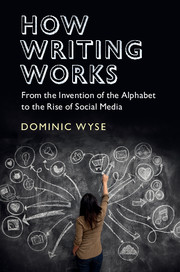Book contents
- How Writing Works
- How Writing Works
- Copyright page
- Dedication
- Contents
- Figures and Tables
- Acknowledgements
- Introduction
- 1 Thinking about Writing and Language
- 2 A History of Writing
- 3 Writing Guidance
- 4 Expert Writers
- 5 Creativity and Writing
- 6 Novice Writers and Education
- 7 The Process of Writing
- Bibliography
- Index
5 - Creativity and Writing
Published online by Cambridge University Press: 12 December 2017
- How Writing Works
- How Writing Works
- Copyright page
- Dedication
- Contents
- Figures and Tables
- Acknowledgements
- Introduction
- 1 Thinking about Writing and Language
- 2 A History of Writing
- 3 Writing Guidance
- 4 Expert Writers
- 5 Creativity and Writing
- 6 Novice Writers and Education
- 7 The Process of Writing
- Bibliography
- Index
Summary
Writing is one of the most potent forms of creative expression, as the work of some of the greatest writers has shown. One dimension of judgements about creativity is the test of time, measured in hundreds of years for the highest levels of creativity. The creative expression that is a part of written composition is also present in a range of other forms. Visual art, dance, architecture, drama, and music all involve creative composition of drawings, paintings, sculptures, dances, buildings, and music. A fundamental element of composition is the need for the composer to generate original ideas from a blank space: whether page (manuscript or screen), canvas, or metaphorical slate. As I mentioned in the previous chapter Thomas Mann articulates the special creativity of artists beautifully in his novel Doctor Faustus, inspired by the Faust legend, a legend that has itself been subject to a range of literary and musical interpretations.
Another example of a very high level of creativity, in text and music combined, is Franz Joseph Haydn's oratorio The Creation. In addition to the importance of The Creation as a representation of creativity, it is an interesting example for a number of reasons. Its subject is creativity, or more accurately, creation itself. The Creation also draws on what is perhaps the most influential text ever written: the Bible, a work which raises profound philosophical questions about the role played by creativity in its own composition. What's more, the Book of Genesis describes what many people would see as the ultimate creative act: God's creation of the universe and all living things.
In the beginning God created the heaven and the earth. And the earth was without form, and void; and darkness was upon the face of the deep. And the Spirit of God moved upon the face of the waters. And God said, Let there be light: and there was light. And God saw the light, that it was good: and God divided the light from the darkness.
For the time of its composition (1798), the beginning of The Creation represented a particularly original opening for a piece of western classical music. The first page of the full score reveals Haydn's depiction of ‘the representation of chaos’.
- Type
- Chapter
- Information
- How Writing WorksFrom the Invention of the Alphabet to the Rise of Social Media, pp. 152 - 177Publisher: Cambridge University PressPrint publication year: 2017



